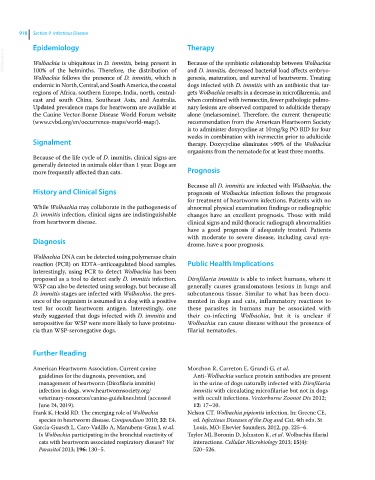Page 980 - Clinical Small Animal Internal Medicine
P. 980
918 Section 9 Infectious Disease
Epidemiology Therapy
VetBooks.ir Wolbachia is ubiquitous in D. immitis, being present in Because of the symbiotic relationship between Wolbachia
100% of the helminths. Therefore, the distribution of
genesis, maturation, and survival of heartworm. Treating
Wolbachia follows the presence of D. immitis, which is and D. immitis, decreased bacterial load affects embryo-
endemic in North, Central, and South America, the coastal dogs infected with D. immitis with an antibiotic that tar-
regions of Africa, southern Europe, India, north, central‐ gets Wolbachia results in a decrease in microfilaremia, and
east and south China, Southeast Asia, and Australia. when combined with ivermectin, fewer pathologic pulmo-
Updated prevalence maps for heartworm are available at nary lesions are observed compared to adulticide therapy
the Canine Vector‐Borne Disease World Forum website alone (melarsomine). Therefore, the current therapeutic
(www.cvbd.org/en/occurrence‐maps/world‐map/). recommendation from the American Heartworm Society
is to administer doxycycline at 10 mg/kg PO BID for four
weeks in combination with ivermectin prior to adulticide
Signalment therapy. Doxycycline eliminates >90% of the Wolbachia
organisms from the nematode for at least three months.
Because of the life cycle of D. immitis, clinical signs are
generally detected in animals older than 1 year. Dogs are
more frequently affected than cats. Prognosis
Because all D. immitis are infected with Wolbachia, the
History and Clinical Signs prognosis of Wolbachia infection follows the prognosis
for treatment of heartworm infections. Patients with no
While Wolbachia may collaborate in the pathogenesis of abnormal physical examination findings or radiographic
D. immitis infection, clinical signs are indistinguishable changes have an excellent prognosis. Those with mild
from heartworm disease. clinical signs and mild thoracic radiograph abnormalities
have a good prognosis if adequately treated. Patients
with moderate to severe disease, including caval syn-
Diagnosis drome, have a poor prognosis.
Wolbachia DNA can be detected using polymerase chain
reaction (PCR) on EDTA–anticoagulated blood samples. Public Health Implications
Interestingly, using PCR to detect Wolbachia has been
proposed as a tool to detect early D. immitis infection. Dirofilaria immitis is able to infect humans, where it
WSP can also be detected using serology, but because all generally causes granulomatous lesions in lungs and
D. immitis stages are infected with Wolbachia, the pres- subcutaneous tissue. Similar to what has been docu-
ence of the organism is assumed in a dog with a positive mented in dogs and cats, inflammatory reactions to
test for occult heartworm antigen. Interestingly, one these parasites in humans may be associated with
study suggested that dogs infected with D. immitis and their co‐infecting Wolbachia, but it is unclear if
seropositive for WSP were more likely to have proteinu- Wolbachia can cause disease without the presence of
ria than WSP‐seronegative dogs. filarial nematodes.
Further Reading
American Heartworm Association. Current canine Morchon R, Carreton E, Grandi G, et al.
guidelines for the diagnosis, prevention, and Anti‐Wolbachia surface protein antibodies are present
management of heartworm (Dirofilaria immitis) in the urine of dogs naturally infected with Dirofilaria
infection in dogs. www.heartwormsociety.org/ immitis with circulating microfilariae but not in dogs
veterinary‐resources/canine‐guidelines.html (accessed with occult infections. Vectorborne Zoonot Dis 2012;
June 24, 2019). 12: 17–20.
Frank K, Heald RD. The emerging role of Wolbachia Nelson CT. Wolbachia pipientis infection. In: Greene CE,
species in heartworm disease. Compendium 2010; 32: E4. ed. Infectious Diseases of the Dog and Cat, 4th edn. St
Garcia‐Guasch L, Caro‐Vadillo A, Manubens‐Grau J, et al. Louis, MO: Elsevier Saunders, 2012, pp. 225–6.
Is Wolbachia participating in the bronchial reactivity of Taylor MJ, Boronin D, Johnston K, et al. Wolbachia filarial
cats with heartworm associated respiratory disease? Vet interactions. Cellular Microbiology 2013; 15(4):
Parasitol 2013; 196: 130–5. 520–526.

